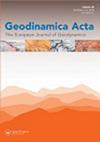Petrology and geochemistry of eclogites from the Biga Peninsula, Northwest Turkey
IF 1.5
Q1 Earth and Planetary Sciences
引用次数: 7
Abstract
The Biga Peninsula in northwest Turkey contains high-pressure metabasic eclogite that occur in two localities; as lenses within a 2 km long, 500 m thick quartz-phengite schist slice that is in turn found in the greenschist-facies metasedimentary rocks of the Çamlıca metamorphics, in Çamlıca area, and in two north-south elongated eclogites occurring as a tectonic slice between Kazdağ Massif and Çetmi Group, in Çetmi area. The P-T conditions under which these two exposures of eclogites formed are important to quantify the tectonic processes of subduction, exhumation and emplacement that high-pressure rocks of the Biga Peninsula record. New geochemical data suggest that both protoliths were N-type MORB basalt with high TiO2 and K2O–Na2O content and Nb/Y ratios. Most eclogite samples have tholeiitic signatures volcanic arc settings. ∑REE abundances range from 47.55 to 107.4 ppm. Europium anomalies are slightly variable (Eu/Eu* = 0.9–1.1) and trace element contents are similar to typical MORB based on tectonic discrimination diagrams. All eclogite protoliths were probably derived from depleted mantle source, modified by fluids within the subduction zone. The high-P mineral assemblage in eclogites from both regions is omphacite + garnet + glaucophane + phengite + epidote + zoisite + quartz. The inclusions in garnet are glaucophane, quartz, phengite, Ca-amphibole and rutile. P-T conditions are similar to each other and constrained at 550–700 °C and 16–24 kbar. Geochemical data and mineral chemistry indicate that the eclogites in the Biga Peninsula represent oceanic crust processed at significant depths (50–80 km) within the subduction channel and were juxtaposed with greenschist facies as a tectonic slice in the accretionary complex at higher structural levels.土耳其西北部比加半岛榴辉岩的岩石学和地球化学
土耳其西北部比加半岛含高压变质榴辉岩,分布于两个地方;在Çamlıca地区的Çamlıca变质岩的绿片岩相变质沉积岩中发现了2公里长、500米厚的石英-云母片岩片中的透镜,在Çetmi地区的卡兹达尔地块和Çetmi群之间的两个南北拉长的榴辉岩片中发现了透镜。这两次榴辉岩暴露形成的P-T条件对量化碧加半岛高压岩石记录的俯冲、发掘和侵位构造过程具有重要意义。新的地球化学资料表明,这两种原岩均为n型MORB玄武岩,具有较高的TiO2、K2O-Na2O含量和Nb/Y比值。大多数榴辉岩样品具有拉斑岩特征,火山弧背景。∑REE丰度为47.55 ~ 107.4 ppm。构造辨别图显示,铕异常变化不大(Eu/Eu* = 0.9 ~ 1.1),微量元素含量与典型MORB相似。所有榴辉岩原岩可能来源于衰竭的地幔源,并受到俯冲带内流体的修饰。两个地区榴辉岩的高磷矿物组合为辉长石+石榴石+蓝绢石+辉长石+绿帘石+黝帘石+石英。石榴石中的包裹体主要有蓝绢石、石英、云母、角闪石和金红石。P-T条件彼此相似,限制在550-700°C和16-24 kbar。地球化学和矿物化学资料表明,碧加半岛榴辉岩代表了俯冲通道内显著深度(50 ~ 80 km)的洋壳,并与绿片岩相在较高构造层次的增生杂岩中并列形成构造片。
本文章由计算机程序翻译,如有差异,请以英文原文为准。
求助全文
约1分钟内获得全文
求助全文
来源期刊

Geodinamica Acta
地学-地球科学综合
CiteScore
4.50
自引率
0.00%
发文量
0
审稿时长
25 weeks
期刊介绍:
Geodinamica Acta provides an international and interdisciplinary forum for the publication of results of recent research dealing with both internal and external geodynamics. Its aims to promote discussion between the various disciplines that work on the dynamics of the lithosphere and hydrosphere. There are no constraints over themes, provided the main thrust of the paper relates to Earth''s internal and external geodynamics. The Journal encourages the submission of papers in all fields of earth sciences, such as biostratigraphy, geochemistry, geochronology and thermochronology, geohazards and their societal impacts, geomorphology, geophysics, glaciology, igneous and metamorphic petrology, magmatism, marine geology, metamorphism, mineral-deposits and energy resources, mineralogy, orogeny, palaeoclimatology, palaeoecology, paleoceanograpgy, palaeontology, petroleum geology, sedimentology, seismology and earthquakes, stratigraphy, structural geology, surface processes, tectonics (neoteoctonic, plate tectonics, seismo-tectonics, Active tectonics) and volcanism.
Geodinamica Acta publishes high quality, peer-reviewed original and timely scientific papers, comprehensive review articles on hot topics of current interest, rapid communications relating to a significant advance in the earth sciences with broad interest, and discussions of papers that have already appeared in recent issues of the journal. Book reviews are also included. Submitted papers must have international appeal and regional implications; they should present work that would be of interest to many different specialists. Geographic coverage is global and work on any part of the world is considered. The Journal also publishes thematic sets of papers on topical aspects of earth sciences or special issues of selected papers from conferences.
 求助内容:
求助内容: 应助结果提醒方式:
应助结果提醒方式:


